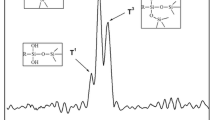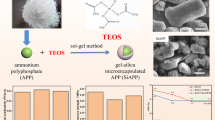Abstract
Ethyl cellulose, a widely used bio-degradable shell material, microencapsulated ammonium polyphosphate (MAPP) was added to the bio-degradable poly(butylene succinate) (PBS) to improve its flame retardancy, compatibility, and thermal stability. The MAPP was well characterized by Fourier transform infrared spectroscopy, X-ray photoelectron spectroscopy, scanning electron microscopy (SEM), water contact angle, and thermogravimetric (TG) analysis. The SEM results indicate the improved dispersion of MAPP into PBS matrix and the formation of the strong interfacial adhesion between MAPP and PBS than APP. With the incorporation of MAPP and char-forming agent into PBS, the limiting oxygen index of the composite was increased to 35.5 %, and the sample can pass the UL-94 V-0 rating, while the un-microencapsulated counterpart cannot reach the rating. The cone calorimeter test showed that the peak heat release rate was decreased by 46.7 % and the burning time was also prolonged compared to the pure PBS. The increased melt flow index and rheology test indicated the increase of viscosity and the improvement of anti-dripping properties. Moreover, the mechanical properties and thermal stability of MAPP composite were also obviously enhanced after the microencapsulation by mechanical, dynamical mechanical thermal analysis, and TG analysis.












Similar content being viewed by others
References
Wu DF, Yuan LJ, Laredo E, Zhang M, Zhou WD. Interfacial properties, viscoelasticity, and thermal behaviors of poly(butylene succinate)/polylactide blend. Ind Eng Chem Res. 2012;51:2290–8.
Liu GM, Zheng LC, Zhang XQ, Li CC, Jiang SC, Wang DJ. Reversible lamellar thickening induced by crystal transition in poly(butylene succinate). Macromolecules. 2012;45:5487–93.
Gallo E, Schartel B, Acierno D, Russo P. Flame retardant biocomposites: synergism between phosphinate and nanometric metal oxides. Eur Polym J. 2011;47:1390–401.
Signori F, Pelagaggi M, Broncoa S, Righetti MC. Amorphous/crystal and polymer/filler interphases in biocomposites from poly(butylene succinate). Thermochim Acta. 2012;543:74–81.
Phua YJ, Lau NS, Sudesh K, Chow WS, Mohd Ishak ZA. Biodegradability studies of poly(butylene succinate)/organo-montmorillonite nanocomposites under controlled compost soil conditions: effects of clay loading and compatibiliser. Polym Degrad Stab. 2012;97:1345–54.
Okamoto K, Sinharay S, Okamoto M. New poly(butylene succinate)/layered silicate nanocomposites. II. Effect of organically modified layered silicates on structure, properties, melt rheology, and biodegradability. J Polym Sci. 2003;41:3160–72.
Chen L, Wang YZ. A review on flame retardant technology in China. Part I: development of flame retardants. Polym Adv Technol. 2010;21:1–26.
Liu Y, Yi JS, Cai XF. The investigation of intumescent flame-retarded polypropylene using poly(hexamethylene terephthalamide) as carbonization agent. J Therm Anal Calorim. 2012;107:1191–7.
Liu Y, Wang JS, Deng CL, Wang DY, Song YP, Wang YZ. The synergistic flame-retardant effect of O-MMT on the intumescent flame-retardant PP/CA/APP systems. Polym Adv Technol. 2010;21:789–96.
Sun LS, Qu YT, Li SX. Co-microencapsulate of ammonium polyphosphate and pentaerythritol in intumescent flame-retardant coatings. J Therm Anal Calorim. 2013;111:1099–106.
Saihi D, Vroman I, Giraud S, Bourbigot S. Microencapsulation of ammonium phosphate with a polyurethane shell part I: coacervation technique. React Funct Polym. 2005;64:127–38.
Liauw CM, Lees GC, Hurst SJ, Rothon RN, Ali S. Effect of silane-based filler surface treatment formulation on the interfacial properties of impact modified polypropylene/magnesium hydroxide composites. Composites A. 1998;29A:1313–8.
Metin D, Tihminlioglu F, Balkose D, Ulku S. The effect of interfacial interactions on the mechanical properties of polypropylene/natural zeolite composites. Composites A. 2004;35:23–32.
Liu SP, Ying JR, Zhou XP, Xie XL, Ma YW. Dispersion, thermal and mechanical properties of polypropylene/magnesium hydroxide nanocomposites compatibilized by SEBS-g-MA. Compos Sci Technol. 2009;69:1873–9.
Pingan S, Shen Y, Du BX, Peng M, Shen L, Fang ZP. Effects of reactive compatibilization on the morphological, thermal, mechanical, and rheological properties of intumescent flame-retardant polypropylene. ACS Appl Mater Interfaces. 2009;1:452–9.
Wen JL, Wei Y, Shu J, Jian MF, Ming BY. Microencapsulation of decabromodiphenyl ether by in situ polymerization: preparation and characterization. Polym Degrad Stab. 2007;92:1359–64.
Vroman I, Giraud S, Salaun F, Bourbigot S. Polypropylene fabrics padded with microencapsulated ammonium phosphate: effect of the shell structure on the thermal stability and fire performance. Polym Degrad Stab. 2010;95:1716–20.
Saihi D, Vroman I, Giraud S, Bourbigot S. Microencapsulation of ammonium phosphate with a polyurethane shell. Part II. Interfacial polymerization technique. React Funct Polym. 2006;66:1118–25.
Trens P, Denoyel R, Rouquerol J. Adsorption of (y-aminopropyl) triethoxysilane on silica from aqueous solution: a microcalorimetric study. Langmuir. 1995;11:551–4.
Casado RM, Lovell PA, Navabpour P, Stanford JL. Polymer encapsulation of surface-modified carbon blacks using surfactant-free emulsion polymerization. Polymer. 2007;48:2554–63.
Wang BB, Hu S, Zhao KM, Lu HD, Song L, Hu Y. Preparation of polyurethane microencapsulated expandable graphite, and its application in ethylene vinyl acetate copolymer containing silica-gel microencapsulated ammonium polyphosphate. Ind Eng Chem Res. 2011;50:11476–84.
Girauda S, Bourbigot S, Rochery M, Vromana I, Tighzert L, Delobel R, Poutchd F. Flame retarded polyurea with microencapsulated ammonium phosphate for textile coating. Polym Degrad Stab. 2005;88:106–13.
Chen XL, Jiao CM, Zhang J. Microencapsulation of ammonium polyphosphate with hydroxyl silicone oil and its flame retardance in thermoplastic polyurethane. J Therm Anal Calorim. 2011;104:1037–43.
Ni JX, Song L, Hu Y, Zhang P, Xing WY. Preparation and characterization of microencapsulated ammonium polyphosphate with polyurethane shell by in situ polymerization and its flame retardance in polyurethane. Polym Adv Technol. 2009;20:999–1005.
Hsu CF, Kilmartin PA. Antioxidant capacity of robust polyaniline–ethyl cellulose films. React Funct Polym. 2012;72:814–22.
Li YX, Liu RG, Liu WY, Kang HL, Wu M, Huang Y. Synthesis, self-assembly, and thermosensitive properties of ethyl cellulose-g-P(PEGMA) amphiphilic copolymers. J Polym Sci A. 2008;46:6907–15.
Wang BB, Tang QB, Hong NN, Song L, Wang L, Shi YQ, Hu Y. Effect of cellulose acetate butyrate microencapsulated ammonium polyphosphate on the flame retardancy, mechanical, electrical, and thermal properties of intumescent flame-retardant ethylenevinyl acetate copolymer/microencapsulated ammonium polyphosphate/polyamide-6 blends. ACS Appl Mater Interfaces. 2011;3:3754–61.
Nie SB, Hu Y, Song L, He QL, Yang DD. Synergistic effect between a char forming agent (CFA) and microencapsulated ammonium polyphosphate on the thermal and flame retardant properties of polypropylene. Polym Adv Technol. 2008;19:1077–83.
Qilong T, Song L, Hu Y. Synthesis, structure–property relationships of polyphosphoramides with high char residues. J Mater Chem. 2011;21:6621–7.
Chenlu B, Yuqiang G, Lei S, Yuan H. Poly(vinyl alcohol) nanocomposites based on graphene and graphite oxide: a comparative investigation of property and mechanism. J Mater Chem. 2011;21:13942–50.
Acknowledgements
The work was financially supported by National Basic Research Program of China (973 Program) (2012CB719701), National Natural Science Foundation of China (No. 51303167) and Opening Project of Southwest University of Science and Technology (No. 11ZXFK12).
Author information
Authors and Affiliations
Corresponding authors
Rights and permissions
About this article
Cite this article
Hu, W., Wang, B., Wang, X. et al. Effect of ethyl cellulose microencapsulated ammonium polyphosphate on flame retardancy, mechanical and thermal properties of flame retardant poly(butylene succinate) composites. J Therm Anal Calorim 117, 27–38 (2014). https://doi.org/10.1007/s10973-014-3680-z
Received:
Accepted:
Published:
Issue Date:
DOI: https://doi.org/10.1007/s10973-014-3680-z




